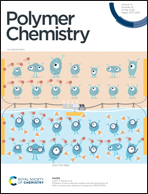Abstract
The synthesis of poly(S-dipentene) with a sulfur content greater than 50 wt% by catalytic inverse vulcanization in the presence of zinc-based accelerators was investigated at 140 °C for the first time. Accelerators reduced the time required for mixing of dipentene and melted sulfur and the best results were obtained with zinc tetrabutyl-bis(phosphorodithioate). Three bio-based dienes, garlic oil (GO), diallyl disulfide (DAS) and myrcene (MYR), were used as crosslinkers in the post-polymerization of poly(S-dipentene). Stable ter-polymers with depressed depolymerization reactions were obtained by adding 10 wt% of MYR, GO or DAS. The ter-polysulfides produced were soft solids with Tg values between −1 and 4 °C. Processable polystyrene–poly(S-dipentene-DAS) blends were prepared with shape persistence, a fundamental requirement to prepare solid objects, and found to be able to remove ferric ions from aqueous solutions for application in wastewater purification. Thus, green polysulfides were obtained, which represent an economical alternative to polysulfides synthesized from enantiomeric limonene.



 Please wait while we load your content...
Please wait while we load your content...